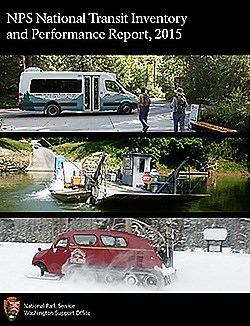
Multi-modal Travel in the National Parks
Although growth in park visitation translates to interest in these special places, as well as economic health for the communities that surround the parks, it significantly stretches park resources. Since almost all travel into and within the national parks is based on personal automobiles, congestion has become an unfortunate part of the park experience. Congestion results in overcrowding, air pollution, resource degradation, and threatening the long-term quality of the parks.
A Memorandum of Understanding (MOU) between the Department of the Interior (DOI) and the Department of Transportation (DOT) signed November 15, 1997 sets forth the goals and strategies for establishing a mutually beneficial relationship to improve transportation in and approaching National Park Service (NPS) facilities.
The 1997 MOU and the 1998 legislation, Transportation Equity Act for the 21st Century (TEA-21), gave the NPS increased responsibility in transportation planning, and paved the way for development of the Alternative Transportation Program (ATP). The ATP coordinates policies, projects and activities related to transportation planning, partnering, and implementation of alternative transportation systems within and to NPS units. The ATP also develops strategies and recommendations for Servicewide application on issues crossing agency and State/Federal lines and jurisdictions.
Demonstration Parks
Five parks, Yosemite National Park, Acadia National Park, Grand Canyon National Park, Zion National Park, and Golden Gate National Recreation Area were identified in the MOU because of their complex transportation challenges. Over the past 20 years the demonstration parks have developed and implemented major transportation improvement strategies to improve access to and within parks.Goals of the ATP:
- Cultivate improvements in transportation connectivity, convenience, and safety for visitors and workforce.
- Provide quality transportation experiences that enhance park visits.
- Demonstrate leadership in environmentally-responsible transportation.
- Ensure the long-term financial viability of NPS transportation infrastructure, systems, and services.
- Manage the transportation program based on meaningful, reliable data.
Alternative Transportation Systems
Many parks use alternative transportation systems (ATS) as a tool to achieve their mission and ultimately the mission of the NPS. ATS integrates all modes of travel within a park, including transit, bicycle and pedestrian linkages, and the automobile; and includes a whole range of technologies, facilities, and transportation management strategies.Many ATS incorporate transit systems to provide access, but it is reasonable to say that not all parks need to embark on a full-scale transit system and that managing the automobile, providing pedestrian and bicycle linkages and employing other management strategies is a part of this integrated approach. Existing alternative transportation systems do and will continue to require improvement in their infrastructure, operations and integration in order to fulfill the mission of the NPS.
Benefits of using ATS in National Parks:
- enhancing the visitor experience;
- minimizing resource impacts where traffic volume on existing roadway infrastructure has reached or is over capacity;
- providing car-free access;
- improving air quality and soundscapes;
- reducing wildlife/auto collisions

Last updated: May 13, 2020
